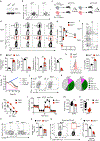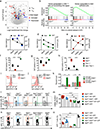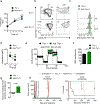The transcription factor c-Myb regulates CD8+ T cell stemness and antitumor immunity
- PMID: 30778251
- PMCID: PMC6489499
- DOI: 10.1038/s41590-018-0311-z
The transcription factor c-Myb regulates CD8+ T cell stemness and antitumor immunity
Abstract
Stem cells are maintained by transcriptional programs that promote self-renewal and repress differentiation. Here, we found that the transcription factor c-Myb was essential for generating and maintaining stem cells in the CD8+ T cell memory compartment. Following viral infection, CD8+ T cells lacking Myb underwent terminal differentiation and generated fewer stem cell-like central memory cells than did Myb-sufficient T cells. c-Myb acted both as a transcriptional activator of Tcf7 (which encodes the transcription factor Tcf1) to enhance memory development and as a repressor of Zeb2 (which encodes the transcription factor Zeb2) to hinder effector differentiation. Domain-mutagenesis experiments revealed that the transactivation domain of c-Myb was necessary for restraining differentiation, whereas its negative regulatory domain was critical for cell survival. Myb overexpression enhanced CD8+ T cell memory formation, polyfunctionality and recall responses that promoted curative antitumor immunity after adoptive transfer. These findings identify c-Myb as a pivotal regulator of CD8+ T cell stemness and highlight its therapeutic potential.
Conflict of interest statement
COMPETING FINANCIAL INTERESTS
P.B and B.W.H. are full-time employees of MedImmune and have stock in AstraZeneca. S.G., Y.J. and L.G. have a pending patent on c-Myb technology. Other authors have no competing interests.
Figures







References
METHODS-ONLY REFERENCES
-
- Gu Z, Eils R & Schlesner M Complex heatmaps reveal patterns and correlations in multidimensional genomic data. Bioinformatics 32, 2847–2849 (2016). - PubMed
Publication types
MeSH terms
Substances
Grants and funding
- P30 CA086862/CA/NCI NIH HHS/United States
- MR/S024468/1/MRC_/Medical Research Council/United Kingdom
- 22597/CRUK_/Cancer Research UK/United Kingdom
- R01 CA085842/CA/NCI NIH HHS/United States
- BB/N007794/1/BB_/Biotechnology and Biological Sciences Research Council/United Kingdom
- R01 GM100776/GM/NIGMS NIH HHS/United States
- BBS/E/B/000C0407/BB_/Biotechnology and Biological Sciences Research Council/United Kingdom
- WT_/Wellcome Trust/United Kingdom
- MC_UP_1502/3/MRC_/Medical Research Council/United Kingdom
- BBS/E/B/000C0409/BB_/Biotechnology and Biological Sciences Research Council/United Kingdom
- ZIA BC011480/ImNIH/Intramural NIH HHS/United States
LinkOut - more resources
Full Text Sources
Other Literature Sources
Medical
Molecular Biology Databases
Research Materials

